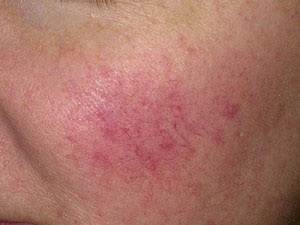Dermatologists know that rosacea involves swelling of veins under the skin but are not yet sure why certain “triggers” produce the fiery red rash associated with rosacea. Affecting millions of adults over 30, rosacea is a benign condition that may be genetic or due to abnormally high levels of specific peptides and enzymes in the bloodstream. Other studies have suggested that rosacea outbreaks are influenced by bacterial proliferation in the small intestine. Regardless of rosacea’s root cause, its appearance is provoked by exposure to irritants, or “triggers” that makes someone blush and flush uncontrollably.
The most common triggers include:
- Sunlight
- Anxiety and stress
- Humid, hot weather
- Dry, cool winds
- Vigorous exercise
- Alcohol
- Hot showers
- Medications and perfumed skin creams
- Spicy foods and caffeinated beverages
What You Should Know About Rosacea
Once the rash begins, it is difficult for the individual to stop it from worsening. Often, bumps and blemishes exacerbate the flushing and tiny blood vessels beneath the skin become glaringly visible. Rosacea may itch, burn or sting, especially in those who already have sensitive skin. Resembling acne at times although it is not related to acne, rosacea indicates a problem with blood vessel functioning rather than overactive sebaceous glands. During a rosacea outbreak, the flushing may spread to the neck, ears, scalp and chest as well, as neighboring blood vessels dilate and cause reddening of the skin.
When someone suffering from rosacea is not having a flushing and blushing attack, he or she often maintains a degree of redness on the areas affected that varies among individuals with rosacea. A type of rosacea called papulopustular rosacea leaves redness and pus-filled red bumps in addition to the furious red blushing that can remain up to four days if left untreated. Another subtype of rosacea frequently seen in men is phymatous rosacea, which causes the nose to enlarge, especially the end of the nose. Symptoms of phymatous rosacea include redness, nodules under the skin, thickening skin and a prominently bulbous nose.
Ocular rosacea, or eye rosacea, commonly occurs in people who already have rosacea and induces distressing symptoms such as itchy, burning eyes, blurred vision, light sensitivity, sties and visibly dilated vessels in the eye’s sclera. Sometimes a lubricating gland called the meibomiam gland becomes plugged because of inflammation, leaving eyes consistently dry and vulnerable to bacterial infection.
Although rosacea is not harmful to your health, it does produce irritating physical symptoms as well as psychological issues such as depression, social anxiety and social isolation because most people with moderate to severe rosacea feel ashamed of their appearance. Rosacea may begin as minor red spots on the cheeks but usually worsens over time, leaving a person affected by the disease feeling too embarrassed and self-conscious to interact normally with others.
Mayoral Dermatology providers understand the stigma involved with having rosacea and provide treatment for this unsightly condition with compassion and insight. The state of the art rosacea therapy sessions offered at our facility are painless and performed by specialists experienced in rosacea improvement technology.
Treatments for Rosacea
Intense Pulsed Light
Instead of delivering one wavelength of light like standard dermatological lasers, intense pulsed light (IPL) emits a broader spectrum of high-intensity light that heats and destroys dysfunctional blood vessels. This process is technically called “selective photothermolysis” which facilitates blood vessel destruction by targeting the blood’s hemoglobin, which quickly absorbs IPL heat and effectively coagulates blood that remains in the vessels. Eventually, useless blood vessels are replaced by scar tissue that does not promote rosacea and its associated symptoms.
Vbeam® Perfecta Pulsed Dye Laser
Similar to IPL is the Vbeam® Perfecta Pulsed Dye Laser, an excellent treatment method to reduce the bright redness and spreading of rosacea. Originally created to eliminate vascular lesions, the Vbeam has now been perfected for use on rosacea and removal of wrinkles around the eyes. Following application of the laser and destruction of blood vessels, collagen production is stimulated which replenishes the skin with the hydrating, firming benefits of collagen. Rosacea patients often see results after three or four sessions with the Vbeam® Perfecta Pulsed Dye Laser. In addition, this easy and painless system requires no post-treatment care so patients can come in during their lunch hour, receive a treatment and return to work that afternoon,
PhotoDynamic Therapy (PDT)
By combining particular light wavelengths with a photosensitizing substance that is activated when exposed to light, PDT can successfully improve your rosacea symptoms and greatly diminish embarrassing pustules, redness and scaling. Mayoral Dermatology uses aminolevulinic acid (Levulan®) to treat skin prior to a PDT session that enhances the ability of the light to target vessels and quickly incapacitate them.
After each photodynamic therapy session, rosacea patients will experience marked improvements in skin texture and tone. Rosacea discolorations and acne-like blemishes continue to decrease steadily and healthy collagen production provides skin with new, healthy cells. Mayoral Dermatology clients can expect to see an 80 to 90 percent improvement in their rosacea after undergoing several PDL treatments.
Topical Treatments
We also offer a variety of the latest topical creams, lotions and serums to relieve rosacea symptoms such as dryness, pustules, swelling, itching and burning. These creams contain anti-inflammatory and antibacterial qualities that help control rosacea in between early laser treatments and keep your skin hydrated and clear. Moisturizers and cleansers are also important for skin maintenance and the control of rosacea. Therapeutic cleansers that do not contain harsh soap, oil-free moisturizers and sunscreens all help inhibit rosacea flare-ups caused by known triggers.


